English
English
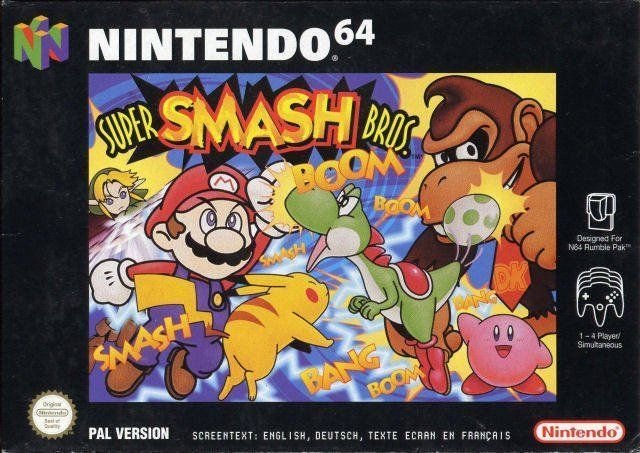
Source
But before I start talking about the game, I'd like to copy the model that Sakurai implements in the Nintendo Directs focused on Smash. By this I mean, usually before he introduce a character in detail, he gives a brief summary of everything related to the character, like a history class.
Without straying too far, let's get started.
A Bit of History
A Bit of History
It was the generation of the PSX and the Nintendo 64, names such as Mortal Kombat, Street Fighter and Tekken, among others, were already strongly heard in the fighting games market.
All of these games were similar, and shared the feature that to make combos, the player had to memorize complex short and long button combinations.
Because of this, improving yourself in fighting games was something that required a lot of time and skill to achieve, which could alienate some of the public for the simple fact of not knowing how to play correctly.
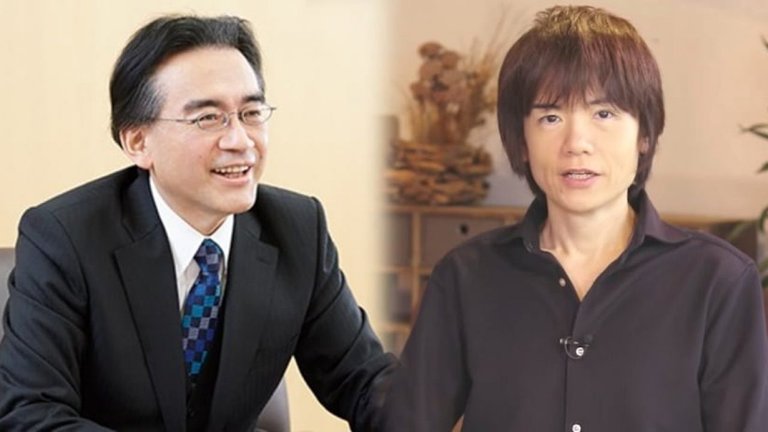
<- Satoru Iwata --[ Source ]-- Masahiro Sakurai ->
For this reason, Sakurai along with Satoru Iwata, were working on a prototype of a game which in the first place did not even have Nintendo characters, it was called "King Dragon: The Game of Fight".
The main idea was to create a fighting game different from the rest, without having to memorize button combinations for each character or press buttons at breakneck speeds for the combos to come out successfully, in short, an easy-to-understand fighting game that everyone could enjoy.
However, Sakurai wanted characters that were easily recognizable by the public, here the idea arose to introduce those of Nintendo, but since it is a company that has always taken great care of its characters, this was difficult to achieve.
Despite this, Sakurai created a prototype using 4 of the characters that would end up in the final product: Mario, Fox, Samus and Donkey Kong, when he presented it, he was given the green light to produce the game, but on a low budget.
However, the result would be just the beginning of a very iconic franchise with followers around the world, and even with its own space in e-Sports today, but for now, let's focus on the characteristics of the former.
Gameplay
Gameplay
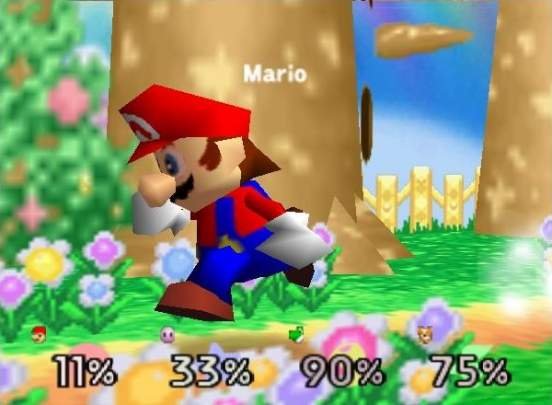
Source
As I said above, the game was focused on being different from the rest of the fighting titles available on the market, which it did extremely well.
Here instead of fights between two characters, a maximum of 4 was allowed, being controllable by players or by the cpu, the catalog of characters starts with 8, but has 4 more unlockables for a total of 12 characters:
- Mario
- Link
- Donkey Kong
- Samus
- Fox
- Pikachu
- Yoshi
- Kirby
The unlockables are:
- Jigglypuff
- Captain Falcon
- Luigi
- Ness
We have 9 stages we can select, based in the franchises that appears in the game.
Combat
Combat

Fuente
The point that differentiates Smash from the rest is its characteristic combat system, where all characters are controlled in the same way, but their movements are different.
Let me explain, each character has their own unique move set, but each move is assigned to a specific button and stick mix. This model has been transferred to each new installment with modifications, but the base is always the same.
Basic Attacks > A
Basic Attacks > A
Of these there are two types, normal and strong, the difference to do one or the other is that to do the normal we must press A while tilting the stick in one direction, and the strong is done by pressing A and tilting the stick at the same time.
Each character has 5 basic attacks: Neutral, Side, Reverse Side (Aerial only), Up and Down, which are executed depending on the direction of the stick, if we do not use the stick at no time will the neutral attack be executed.
Special Attacks > B
Special Attacks > B

Source
Again they depend on the direction of the stick, but instead of A we use B, of these there are only 4 variants: Neutral, Side, Up and Down, generally the Up+B usually works also as a way to return to the platform in addition to jumps, the vast majority of characters have a recovery of this type, but there are also some whose Side+B works as recovery, for example, Fox and Jigglypuff have side attacks that make them gain additional momentum to their jumps.
Shield, Grab and Dodge
Shield, Grab and Dodge
All the characters have a shield which as we use it will be reduced, but it recovers when we do not use it, if it ends completely we will be stunned for long enough to be sent to fly.
While using the shield, we can dodge sideways if we tilt the stick left or right, while the character dodges we will have a period of invulnerability. We can also dodge on the spot, without moving, but it is a technique that takes longer to perfect to get the most out of it.
Apart from all this, each character also has a different type of grab, but globally they are divided into two types, physical grabs, and long-range grabs, almost all characters have short-range hand grabs, but others like Link and Samus have hooks with which they can grab enemies, each type of grab is effective in its own way.
Items
Items
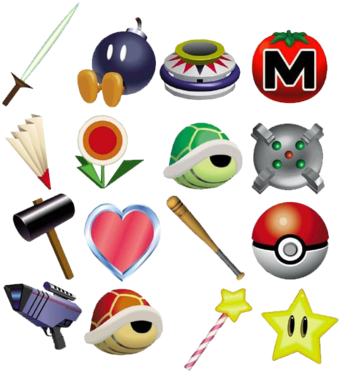
Source
Occasionally different objects taken from each character's franchise will appear on stage, such as Mario's Fire Flower, Donkey Kong's Hammer, or Zelda's Heart Container, they can also come inside capsules, barrels and boxes , but you have to be careful because sometimes they can be an explosive trap.
Main Game Modes
Main Game Modes
1 Player
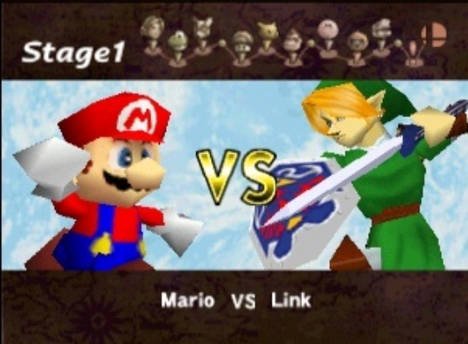
Source
The first one we find is the single player mode, in which we will fight against fighters controlled by the cpu, the pattern is always the same, the first opponent will always be Link, and the last one will always be Master Hand, a giant hand which is the final boss of the game.
The variant in this mode is the difficulty, we have 5 different levels of difficulty to choose from Very Easy to Very Hard, we can also modify the number of stocks we will have before losing, being able to choose a minimum of one and a maximum of 5.
Vs Mode
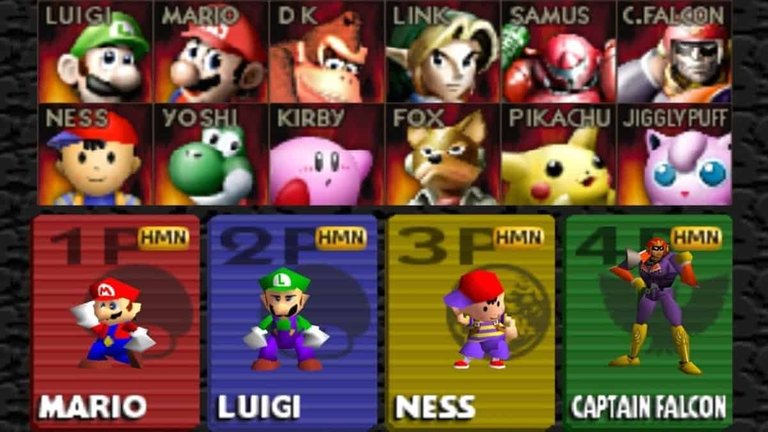
Source
The traditional Smash game mode, where we can fight against three other characters controlled by the cpu or our friends, parameters such as time, number of stocks, items, handicap, etc. can be edited.
Depending on how we have configured it, the winner will be decided within a time limit, or when there is only one standing in case of playing with stocks.
Another thing that Smash differs from is that there are no life bars, but a meter called percentage of damage, this meter increases with each hit a character suffers, and each time it will make it easier to send the character flying away, since the only way to win is by taking enemies out of the margin of the screen.
Soundtrack
Soundtrack
The soundtrack consists mostly of arrangements of songs from different franchises, each stage has an allusive musical theme to maintain the agreement between stage and soundtrack.
Personally I really like the soundtrack of Hyrule Castle, scene corresponding to Link from The Legend of Zelda, which is an arrangement of the main theme of the franchise, as legendary as its name.
Final Comments
Final Comments
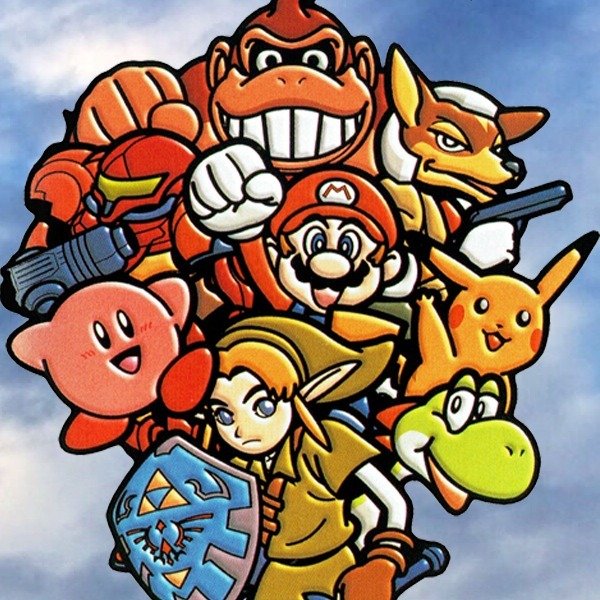
Source
To be completely honest, Smash in general is my favorite fighting video game franchise by far, I was never able to get used to the complicated Street Fighter or Mortal Kombat combos, however I can enjoy them for a bit, but nothing like a good Smash fight with some friends, where even if someone doesn't know anything about fighting games, they can adapt and enjoy fighting.
And the truth Smash 64 is just the beginning of everything, with Melee, its sequel, everything would go even further, more characters, more scenarios, and a deeper gameplay which has endured for years in the competitive field, but that already gives for another post.
Here ends today's post, I hope you liked it and thank you very much for reading up to this point, as always leave me your experiences with any franchise title in the comments.
Without much more to add, see you in the next post, bye bye.
Español
Español

Fuente
Pero antes de empezar a hablar sobre el juego, me gustaría copiar el modelo que Sakurai implementa en los Nintendo Directs enfocados en Smash. Con esto me refiero, a que por lo general antes de introducir a un personaje en detalle, da un breve resumen de todo lo relacionado al personaje, como si fuera una clase de historia.
Sin desviarnos mucho, empecemos.
Un Poco de Historia
Un Poco de Historia
Era la generación de la PSX y la Nintendo 64, en el mercado de juegos de pelea ya sonaban fuertemente nombres como Mortal Kombat, Street Fighter y Tekken, entre otros.
Todos estos juegos eran similares, y compartían la característica de que para hacer combos, el jugador tenía que aprender de memoria complejas combinaciones de botones, cortas y largas.
Debido a esto, perfeccionarse en juegos de pelea era algo que requería mucho tiempo y destreza para lograrse, lo cual podría alejar parte del público por el simple hecho de no saber como jugar correctamente.

<- Satoru Iwata --[ Fuente ]-- Masahiro Sakurai ->
Por esto, Sakurai junto a Satoru Iwata, estaban trabajando en un prototipo de un juego el cual en primer lugar ni siquiera tenía personajes de Nintendo, se llamaba "King Dragon: The Game of Fight".
La idea principal era crear un juego de peleas diferente al resto, sin necesidad de memorizar combinaciones de botones por cada personaje o presionar botones a velocidades vertiginosas para que los combos salieran exitosamente, en resumen, un juego de peleas fácil de entender que todos pudieran disfrutar.
Sin embargo, Sakurai quería personajes que fueran fácilmente reconocibles por el público, aquí surgió la idea de introducir a los de Nintendo, pero dado que es una empresa que toda la vida ha cuidado mucho de sus personajes, esto era complicado de lograr.
A pesar de esto Sakurai creó un prototipo usando a 4 de los personajes que acabarían en el producto final: Mario, Fox, Samus y Donkey Kong, al presentarlo se le dio luz verde para producir el juego, eso sí, con bajo presupuesto.
Sin embargo el resultado sería solo el comienzo de una franquicia muy icónica con seguidores en todo el mundo, y hasta con su propio espacio en los e-Sports a día de hoy, pero por ahora, centrémonos en las características del primero.
Gameplay
Gameplay

Fuente
Como dije un poco más arriba, el juego estaba centrado en ser diferente al resto de títulos de pelea disponibles en el mercado, cosa que logró extremadamente bien.
Aquí en lugar de peleas entre dos personajes, se admitía hasta un máximo de 4, pudiendo ser controlables por jugadores o por la cpu, el catalogo de personajes empieza con 8, pero posee 4 más desbloqueables para un total de 12 personajes:
- Mario
- Link
- Donkey Kong
- Samus
- Fox
- Pikachu
- Yoshi
- Kirby
Los desbloqueables son:
- Jigglypuff
- Captain Falcon
- Luigi
- Ness
Contamos con un total de 9 escenarios para escoger, basados en diferentes juegos de Nintendo.
Combate
Combate

Fuente
El punto que diferencia a Smash del resto es su característico sistema de combate, donde todos los personajes se controlan de la misma forma, pero sus movimientos son diferentes.
Me explico, cada personaje tiene su set de movimientos único, pero cada movimiento está asignado a una mezcla de botón y palanca específica. Este modelo se ha trasladado a cada nueva entrega con modificaciones, pero la base siempre es la misma.
Ataques básicos
Ataques básicos
De estos hay dos tipos, normales y cargados, la diferencia para hacer uno u otro, es que para hacer el normal debemos presionar A mientras inclinamos la palanca en una dirección, y el cargado se hace presionando A e inclinando la palanca al mismo tiempo.
Cada personaje tiene 5 ataques básicos: Neutral, Lateral, Lateral Inverso (Sólo aéreo), Hacia Arriba y Hacia Abajo, los cuales se ejecutan dependiendo de la dirección de la palanca, si no usamos la palanca en ningún momento se ejecutará el ataque neutral.
Ataques especiales
Ataques especiales

Fuente
Nuevamente dependen de la dirección de la palanca, pero en lugar de A utilizamos B, de estos solo hay 4 variantes: Neutro, Lateral, Superior e Inferior, por lo general el Arriba+B suele funcionar también como una forma de volver a la plataforma adicional a los saltos, la gran mayoría de personajes cuentan con un recovery de este tipo, pero también hay algunos cuyo Lateral+B funciona como recovery, por ejemplo, Fox y Jigglypuff tienen ataques laterales que les hacen ganar impulso adicional a sus saltos.
Escudo, Agarre y Esquive
Escudo, Agarre y Esquive
Todos los personajes cuentan con un escudo el cual conforme lo usemos se irá reduciendo, pero se recupera cuando no lo usamos, si se acaba completamente quedaremos aturdidos por el tiempo suficiente para que nos manden a volar.
Mientras utilizamos el escudo, podemos esquivar hacia los lados si inclinamos la palanca hacia la izquierda o derecha, mientras el personaje esquiva tendremos un periodo de invulnerabilidad. También se puede esquivar en el sitio, sin moverse, pero es una técnica que lleva más tiempo perfeccionar para aprovecharla al máximo.
Aparte de todo esto, cada personaje tiene también un tipo de agarre distinto, pero globalmente se dividen en dos tipos, los agarres físicos, y los agarres de largo alcance, casi todos los personajes tienen agarres con la mano a corto alcance, pero otros como Link y Samus tienen ganchos con los cuales pueden agarrar a los enemigos, cada tipo de agarre es efectivo a su manera.
Objetos
Objetos

Fuente
De vez en cuando en el escenario aparecerán diferentes objetos sacados de la franquicia de cada personaje, como la flor de fuego de Mario, el Martillo de Donkey Kong, o el Contenedor de Corazón de Zelda, también pueden venir dentro de capsulas, barriles y cajas, pero hay que tener cuidado pues a veces pueden ser una trampa explosiva.
Principales Modos de Juego
Principales Modos de Juego
1 Player

Fuente
El primero que encontramos es el modo para un jugador, en el cual pelearemos contra luchadores controlados por la cpu, el patrón siempre es el mismo, el primer oponente siempre será Link, y el último siempre será Master Hand, una mano gigante la cual es el jefe final del juego. La variante en este modo es la dificultad, tenemos 5 niveles de dificultad diferentes para escoger desde Very Easy hasta Very Hard, también podemos modificar la cantidad de vidas que tendremos antes de perder, pudiendo elegir un mínimo de una vida y un máximo de 5.
Vs Mode

Fuente
El modo de juego tradicional de Smash, donde podremos pelear contra otros tres personajes controlados por la cpu o nuestros amigos, pueden editarse parámetros como el tiempo, cantidad de vidas, objetos, handicap, etc.
Dependiendo de como lo hayamos configurado, el ganador se decidirá dentro de un tiempo límite, o cuando solo quede uno en pie en caso de jugar con vidas.
Otra cosa en la que se diferencia Smash, es que no hay barras de vida, sino un medidor llamado porcentaje de daño, este medidor aumenta con cada golpe que sufra un personaje, y cada vez causará que sea más fácil enviar volando lejos al personaje, ya que la única forma de ganar es sacando a los enemigos por el margen de la pantalla.
Soundtrack
Soundtrack
El soundtrack se compone en su mayoría de arreglos de canciones procedentes de diferentes franquicias, cada stage tiene un tema musical alusivo para mantener la concordancia entre stage y banda sonora.
Personalmente me gusta mucho el soundtrack del Castillo de Hyrule, escenario correspondiente a Link de The Legend of Zelda, el cual es un arreglo del tema principal de la franquicia, tan legendario como su mismo nombre.
Comentarios Finales
Comentarios Finales

Fuente
Siendo totalmente sincero, Smash en general es mi franquicia de videojuegos de pelea favorita con mucha diferencia, nunca pude acostumbrarme a los combos complicados de Street Fighter o Mortal Kombat, sin embargo puedo disfrutarlos por un rato, pero nada como unas buenas partidas de Smash con algunos amigos, donde aunque alguien no sepa nada sobre juegos de pelea, pueda adaptarse y disfrutar de las peleas.
Y la verdad Smash 64 es solo el comienzo de todo, con Melee, su secuela, todo iría aún más allá, más personajes, más escenarios, y un gameplay más profundo el cual ha perdurado por años en el ámbito competitivo, pero eso ya da para otro post.
Aquí termina el post de hoy, espero les haya gustado y muchas gracias por leer hasta este punto, como siempre déjenme sus experiencias con cualquier título de la franquicia en los comentarios.
Sin mucho más que agregar, nos vemos en el próximo post, bye bye.
Que excelente post, su creador fue un genio, utilizar a los mejores personajes para unirlos en un solo juego. 🎮
Ciertamente, Sakurai creó una gran franquicia de la cual ni siquiera se esperaba gran cosa, pero ya van 5 generaciones de Smash y contando, así que el éxito es más que palpable. Gracias por tu comentario, un saludo.
Great post. This game is a classic one.
Sure it is! Thanks for your comment.
Congratulations @stk-g! You have completed the following achievement on the Hive blockchain and have been rewarded with new badge(s) :
You can view your badges on your board And compare to others on the Ranking
If you no longer want to receive notifications, reply to this comment with the word
STOPDo not miss the last post from @hivebuzz:
Support the HiveBuzz project. Vote for our proposal!